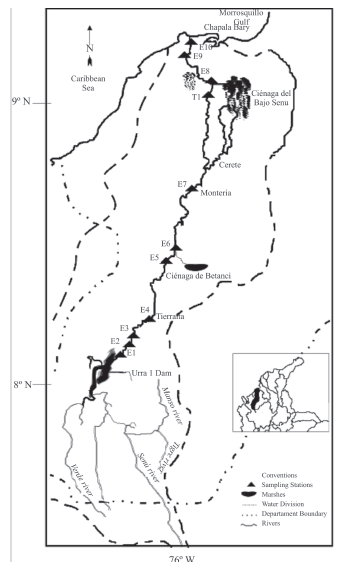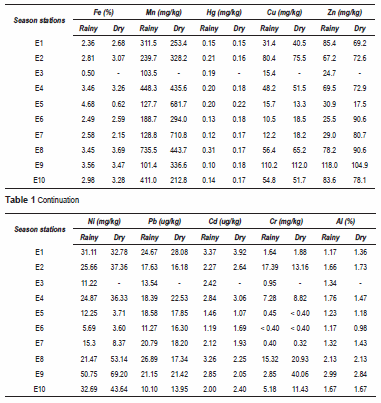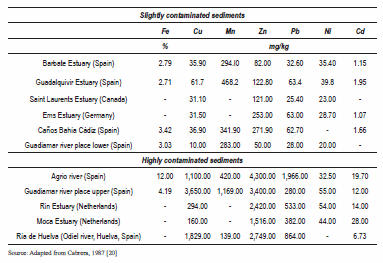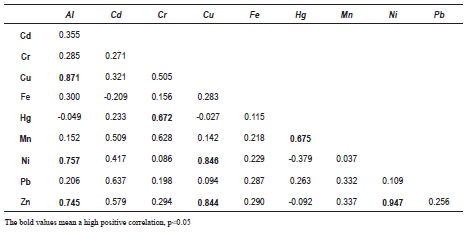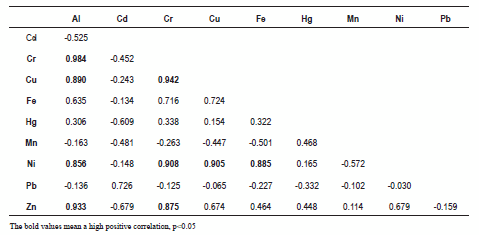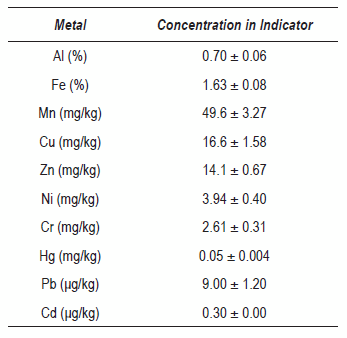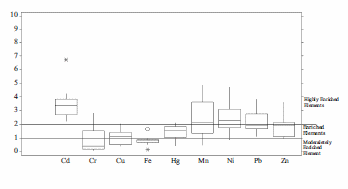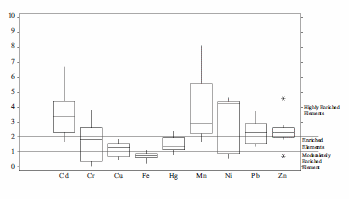Services on Demand
Journal
Article
Indicators
-
 Cited by SciELO
Cited by SciELO -
 Access statistics
Access statistics
Related links
-
 Cited by Google
Cited by Google -
 Similars in
SciELO
Similars in
SciELO -
 Similars in Google
Similars in Google
Share
Revista Facultad de Ingeniería Universidad de Antioquia
Print version ISSN 0120-6230On-line version ISSN 2422-2844
Rev.fac.ing.univ. Antioquia no.55 Medellín Sept. 2010
Heavy metals in Sinú river, department of Córdoba, Colombia, South America
Metales pesados en el río Sinú, departamento de Córdoba, Colombia, Sudamérica
John Jairo Feria1*, José Luis Marrugo2, Humberto González3
1Universidad Pontificia Bolivariana, km 8 vía Cereté, Montería, Colombia
2Universidad de Córdoba, Carrera 6 N.° 76-103 Montería, Colombia
3Aguas de Cartagena, ETAP El Bosque Cartagena, Colombia
Abstract
Concentrations of Al, Fe, Mn, Zn, Cu, Ni, Cr, Hg, Pb and Cd in superficial sediments of river Sinú were studied. Samples were collected in 10 sampling stations downstream from Urrá 1 dam, taking into account two sampling periods, one during rainy season and the other during dry season. Metal concentrations were determined by spectrophotometry or by voltametry, they were normalized with regard to aluminum concentrations, which is a conservative element. It was observed that there was a high concentration of Cu, Ni, Cr and Zn for both sampling periods, which suggesting a common origin. Furthermore, a high level of heavy metal sediment concentrations was pointed out by the enrichment factor test for each of the evaluated elements, except Fe. Places receiving a high impact of floodplains exhibited a larger concentration of heavy metals in sediments, as compared to other basin areas, which is associated with sulfate decrease and sulfides formation and subsequent release and availability of heavy metals.
Keywords: heavy metals, sediment, river Sinú, flood, Colombia
Resumen
Se evaluaron las concentraciones de Al, Fe, Mn, Zn, Cu, Ni, Cr, Hg, Pb y Cd en sedimentos superficiales del río Sinú. Las muestras se recolectaron en 10 sitios de muestreo aguas abajo del embalse de Urrá I, considerándose dos períodos de muestreo, uno en época de lluvia y otro en época seca. Las concentraciones de los metales se determinaron por espectrofotometría de absorción atómica o por voltametría y se normalizaron con respecto a las concentraciones del aluminio, por ser un metal conservativo. Se observó una fuerte correlación entre las concentraciones de Cu, Ni, Cr y Zn para ambos períodos muestreados, sugiriendo un origen común. Adicionalmente, el factor de enriquecimiento indicó para todos los elementos evaluados, a excepción del Fe, concentraciones enriquecidas de metales pesados en los sedimentos. En los sitios que reciben el impacto de los suelos inundados, existe una mayor concentración de metales en los sedimentos, comparada con otras zonas de la cuenca, lo cual se asocia con la reducción de sulfatos y la formación de sulfuros y la subsecuente liberación y disponibilidad de metales pesados.
Palabras clave: metales pesados, sedimentos, río Sinú, inundación, Colombia
Introduction
Heavy metals exist in the environment as a result of natural processes and as pollutants derived from human activities [1]. Heavy metals are stable and persistent pollutants in aquatic environments. The importance of metals like Zn, Cu, Fe, and Mn is that they are essential for the metabolism of organisms, the problem with them being the narrow border between their necessity and toxicity. Other heavy metals like Cd, Hg, Cr and Pb can have a similar extreme level of toxicity, even in low concentrations under given conditions; therefore, they require monitoring in delicate water systems [2, 3]. River sediments are deposits of heavy metals since they are more easily retained or accumulated than in water [4], which is why they should be considered of high scientific interest [5].
Distribution of heavy metals in bottom sediments is affected by the mineral composition and the composition of suspended material, by the anthropogenic influence and in situ processes like sediment deposition, absorption and enrichment by microorganisms [5]. It is thus convenient to monitor the behavioral pattern of conservative elements and grain size indicators in order to detect whether or not they follow the same geographic distribution pattern than those elements potentially contributed by human activities [6]. The latter can be achieved thanks to the normalization of the studied metals as related to a conservative metal that is abundant and scarcely influenced by different human activities. Frequently, normalization of metal concentrations is done bearing an element of reference, such as Al, Fe, Li, and Sc [7, 8].
Several indexes are used in order to estimate the degree of metal pollution in sediments, among which enrichment factor stands out due to the relationship it establishes between the element concentration in samples and element concentrations with their background values, which has been previously normalized to the element of reference [6].
The purpose of the present study was to assess the baseline of heavy metals for sediments of river Sinú, quantify their enrichment factors along the river course, establish the degree of pollution and determine their origin.
Study areas
The river Sinú basin is located in the northwest of Colombia, in South America, more specifically in the southwest area of the Colombian Caribbean coast, within the departments of Córdoba and Antioquia. It originates in the Paramillo massif, which ranges between 7° 8' 9'' and 9° 27' 2'' north latitudes and 75° 55' 31'' and 75° 58' 18'' west longitudes. The river Sinú is the main water system in the department of Córdoba, since besides fertilizing its valley - which is the stage of an intense agricultural and livestock activity - it represents an important supplier of fish species, thus becoming one of the main ecosystems of the Colombian Caribbean coast.
The river is stored by the Urrá 1 hydroelectric dam, within coordinates 8° 01' 10'' north latitude and 76° 12' 08'' west longitude. Along its course, river Sinú has a complex interaction with streams, marshes and swamps that flow into it and regulate its level pikes during maximum flood periods [9].
Materials and methods
Using a Van Veen dredge, samples of superficial sediments were collected in eleven stations located beside the river course, downstream from the Urrá 1 dam during both of the climatic seasons of the region, rainy season (November 2007) and dry season (February 2008), analyzing the concentrations of Al, Fe, Mn, Zn, Cu, Ni, Cr, Hg, Pb and Cd for each station. In order to determine the background values, one core of T1 station was selected, trough a PVC tube of 7 cm in diameter, with a depth of 40 cm and 3 cm sections each. The fresh solid material was stored in plastic containers and was refrigerated at 4°C degrees until its processing at the laboratory. All samples were dried at room temperature with the purpose of preventing mercury volatilization due to heating [10]. Samples were crushed with a stainless-steel mill, subsequently sieved through a 60µm mesh and then made homogenous in order to ensure sample representativeness according to the procedure explained by Ávila and Zarazúa [11]. For determining total metal concentrations, 1 gram sample (dry weight) was digested with HNO3/HCl (3:1) for two hours or until the complete consumption of the sample [12, 13]; Hg was digested with H2SO4/HNO3/ KMnO4 [14]. Metal contents were determined by atomic absorption spectrophotometry with air-acetylene flame (Fe, Mn, Ni, Cr), acetylene- nitrous-oxide flame (Al) or cold vapor (Hg) and by voltametry (Pb, Cd, Cu, Zn). Quality control was performed by triplicate analysis of a standard sediment sample (International Atomic Energy Agency, IAEA - 405). Accuracy, expressed as recovery average, ranged between 97.1% and 99.1%, and precision, as variation coefficient, between 1.4% and 3.1%.
Presence of heavy metal pollutants in river Sinu sediments was assessed normalizing metal concentrations with aluminum concentrations. Correlation matrixes were likewise established between heavy metals in order to identify their type and possible characteristics common to pollution sources. For assessing the Enrichment Factor (EF), concentrations of given elements existing in the environment were compared with those normally expectable if anthropic contribution were excluded, that is, within the regional background. It is calculated as follows:
EF = [Metal/All]sediment / [Metal/All]Background
Depending on the EF values found for each of the studied metals in river Sinu sediments, they were classified in groups of moderately enriched elements (FE<1), enriched elements (1<FE<2) and highly enriched elements (FE >2), [15]. A p≤ 0.05 significance criterion were used for the dispersion statistical analysis and ANOVAS.
Figure 1 show the location of the monitoring stations considered in the present study.
Results and discussion
All collected sediment samples had a sandy texture, mainly made up of sand coming from rivers of a high sediment dynamics like river Sinu, which registers rates up to 4.2x106 tons per year of suspended load [16]. Average concentration of suspended sediment in river Sinu (349.0 mg/L) is higher than that of rivers like the Amazon (156.2 mg/L) or the Orinoco basin (195.7 mg/L) [17].
Table 1 presents results for both climatic seasons.
No variations in metal concentrations were observed in relation to year season. However, differences did occur in relation to their location: stations showing higher concentrations were located near Urra 1 dam (E1 y E2) and those stations located in the lower basin zone (E8, E9 and E10). High metal concentrations were found in E9, probably due to the contributions of La Doctrina irrigation district, which employs fertilizers in agricultural practices. Superphosphide and other phosphorate fertilizers have high concentrations of Cr, Cu, Ni, Pb y Zn, whilst calcium-based fertilizers have a higher concentration of Pb and Zn [18, 19]. Although it is not simple to make an overall comparison, taking into account the differences likely to appear due to distinct digestion methods and grain size for analysis, table 2 shows heavy metal concentrations for metals of different origin with the purpose of comparing metal concentrations in sediments of river Sinú and assessing its degree of pollution.
Figure 1 Location of the study area and the samples
Table 1 Concentrations of heavy metals in river Sinú sediments (dry weight)
The generality of the average concentrations of Pb, Cd and Zn in river sediments, are of the same order of a few contaminated sediments (Table 2). For Mn, the USEPA has reported values up to 1,100 mg/kg are considered non-contaminated sediments [12] concentration is greater than those found in this work. Hg concentrations are slightly higher than the concentration given by the EPA for non-contaminated sediment (0.17 mg/kg), but is kept in a range between 0.10 mg/kg and 0.31 mg/kg, with tendency to be less than or equal to the reference value along the river.
Table 2 Heavy metals concentrations in sediments of different localities
The concentrations of Cu, Cr and Ni were higher at stations E1, E2, E8, E9 and E10. For station E1 and E2 may be due to industrial waste generated in the process of constructing the dam, because Ni and Cu is used in alloys (Monel: 66% Ni - 32% Cu) and together with Cr, are used to prevent corrosion. For stations E8, E9 and E10, could be explained by the contributions of the lagoon complex of lower Sinu, where fertilizers is widely used. The presence of Pb, Zn and Cu at station E4 could be explained by the dumping of domestic sewage from the municipality of Tierralta, located near the station. Fe and Al, are in relatively uniform concentrations in the sediments along the river, but Al tends to increase at stations E8, E9 and E10, perhaps due to the influence of the lagoon complex of lower Sinu under the high rate of sediment input.
After normalizing metal concentrations in relation to Al concentration, all coefficients of variation are higher than 35% and there is no linear tendency between the concentrations of each normalized metal per station, neither for dry season nor rainy season, which supports the affirmation that the presence of these metals in sediments is due to external contributions on the course. Higher correlation coefficients corresponding to Mn, Cu, Cr, Ni y Zn, values which were strongly affected by the high concentrations of these metals in the stations under the influence of Ciénaga Grande del Bajo Sinú (E8, E9 y E10), which reflects the climatic changeability of floodplain areas that may influence the availability of metal trace, due to the processes that affect its concentration in this type of aquatic environment, such as sediment oxidation by floods, resuspension and drainage of sediments, which ultimately leads to the formation of sulphides and subsequent release of heavy metal [21].
The results of correlations among target metals are shown in tables 3 and 4, where correlation coefficients are also displayed.
Table 3 Correlation coefficients for metals during rainy season
Table 4 Correlation coefficients of metals during dry season
Two groups of highly correlated metals were found in correlation coefficients exceeding 0.65 during both sampling sessions, the first group is made up of Al, Cu, Ni y Zn for rainy season, and dry season registers a similar pattern but for the adding of Cr. A second group of correlated elements corresponds to Cd and Pb for both sampling periods, this could be due to its similar chemical behavior, having a similar ionic radius [22]. It must be highlighted that Hg only shows a significant correlation with Mn in the rainy season, since Mn oxides exhibit strong affinity for adsorption and absorption of Hg and Cr [23] as well as Mn and Cr correlate for the same period. Therefore, correlation coefficients of metals in sediments show strong affinity among them, thus pointing to a common polluting source [24]. High values in found coefficients are probably due to a similar origin of metals, either for contribution of pollutants or the soil lithology, or else as a result of a similar pattern of metals. The highest metal concentrations occur in floodplain areas, which are prone to sediment formation with high levels of organic matter, when flooding is long enough in these soils, they can be the ideal ground for sulfate reduction and the formation of acid volatile sulfides, causing subsequent release and availability of heavy metals [25]. On the other hand, concurrence of Cu, Zn, Al, Cd, Mn and Cr may also be accounted as a similarity of origin as by-products of P-based fertilizers [18] or by mining. Mining grounds were not found along the river course in previous studies and, according to other studies, fertilizers widely used in the river valley do not contain correlating heavy metals as active ingredients [26], which suggests a continuous lithological contribution to sediments in the river basin. Background values of indicator T1 as described in table 5 were selected for the calculation of enrichment factors.
Table 5 Background values selected for station T1
Mean concentration ≠ Standard deviation
Figures 2 and 3 show enrichment factors found for the sampled events
Figure 2 Enrichment factors for sediments of river Sinu during rainy season
Figure 3 Enrichment factors for sediments of river Sinu during dry season
Highly enriched metals in river Sinu sediments are Cd, Mn and Ni, whilst those simply considered as enriched are Cr, Cu, Hg, Pb and Zn, the former showing a tendency to moderately enriched during rainy season and the latter to grow highly enriched during dry season.
Those Enrichment Factor (EF) values approaching 1 in both situations are considered to indicate, to a large extent, a natural source; whereas EF values exceeding 1.5 suggest that these come from other anthropogenic or natural source that depends on aluminum-silicate fraction [6], in such a way that availability of heavy metals - except for Al and Fe, which are conservative elements - is likely to occur as a result of contributions external to them, such as large sediment contribution from erosion due to sudden level shifts in the river course, which constitutes a more severe damage to aquatic environments. If intensive use of agrochemical fertilizers in regional agriculture is added, one more contribution to yet high erosion can be identified, since river Sinú valley is made up of excessively pastured crop and forest lands [26].
Another possible source of metal enrichment in sediments - especially in stations E1, E2, E3 y E4, is the influence of Urrá 1 dam, which floods 7400 Ha, thus accelerating washout and metal release processes and other constituent elements of the affected soil, spreading them downstream from the dam.
Conclusions
Presence of heavy metals in river Sinú is mainly due to soil washout, especially in floodplain areas, where metal availability is higher, in addition to erosion processes occurring in the river banks, which yield a large sediment contribution to the course. Highly toxic heavy metals, like Pb and Cd, were found in insignificant concentrations. However, the stations affected by the dam and dumping of Ciénaga Grande del Bajo Sinú, show higher concentrations of metals. Except for conservative elements Al and Fe, the rest of heavy metals studied in sediments show enrichment in their concentrations.
Acknowledgements
J.J. Feria, thanks the University of Córdoba and Universidad Pontificia Bolivariana in Monteria for their valuable support in the accomplishment of this research project.
References
1. H. Karadede, E. Unlu. ''Heavy Metal Concentrations in Water, Sediment, Fish and Some Benthic Organisms from Tigris river, Turkey''. Environmental Monitoring and Assessment. Vol. 131. 2007. pp. 323-337. [ Links ]
2. T. Cohen, S. Hee, R. Ambrose. ''Trace metals in fish and invertebrates of three California Coastal Wetlands''. Marine Pollution Bulletin. Vol. 42. 2001. pp. 232-242. [ Links ]
3. J. E. Fergusson. The heavy elements: Chemistry, environmental impact and health effects. Ed. Pergamon Press. New York. 1990. pp. 614. [ Links ]
4. L. Hakanson. ''An ecological risk index for aquatic pollution control: A sedimentological approach''. Water Research. Vol. 14. 1980. pp. 975-1001. [ Links ]
5. C. K. Jain, D. C. Singhal, M. K. Sharma. ''Metal pollution assessment of sediment and water in the river Hindon, India''. Environmental Monitoring and Assessment. Vol. 105. 2005. pp 193-207. [ Links ]
6. B. Rubio, M. A. Nombela. F. Vilas. ''Heavy metal pollution in the Galician Rías Baixas: new background values for Ría de Vigo (NWSpain)''. Journal of Iberian Geology. Vol. 26. 2000. pp. 121-149. [ Links ]
7. S. Covelli, G. Fontolan. ''Application of a normalization procedure in determining regional geochemical baselines''. Environmental Geology. Vol. 30. 1997. pp. 34 - 45. [ Links ]
8. M. Aloupi, M. Angelidis. ''Normalization to lithium for the assessment of metal contamination in coastal sediment cores from the Aegean Sea, Greece''. Marine Environmental Research. Vol. 52. 2001. pp. 1-12. [ Links ]
9. Corporación Autónoma Regional de los Valles del Sinú y del San Jorge (CVS). Universidad de Córdoba. Fases de prospección y formulación del plan de Ordenamiento y Manejo Integral de la Cuenca hidrográfica del río Sinú (Pomca-Rs). Informe Técnico. Montería. Colombia. 2006. pp. 691. [ Links ]
10. E. F. Herrera, R. Pérez. Métodos de análisis por activación neutrónica (AAN). Curso nacional de aplicación de las técnicas analíticas nucleares a estudios del medio ambiente. ARCAL IV. La Habana (Cuba). 1993. pp. 83. [ Links ]
11. P. P. Avila, O. G. Zarazúa. Concentración de metales pesados en agua, sedimento y lirio acuático de la presa José Antonio Alzate, Estado de México. Informe Técnico CA-94-17. Instituto Nacional de Investigaciones Nucleares. México. 1994. pp. 353. [ Links ]
12. USEPA. Method Study 37- SW-846. Method 3052 Acid Digestion of sediments, sludges, and soils. EPA Contract Vol. 68 -03 -3254. 1988. [ Links ]
13. H. K. Akin, E. Unlu. ''Heavy Metal Concentrations in Water, Sediment, Fish and Some Benthic Organisms from Tigris river, Turkey''. Environmental Monitoring and Assessment. Vol. 131. 2007. pp. 323-337. [ Links ]
14. M. Sadiq, T. Zaidi, M. A. Mohana. ''Sample weight and digestion temperature as critical factors in mercury determination in fish''. Bulletin of Environmental Contamination and Toxicology. Vol. 47. 1991. pp. 335-341. [ Links ]
15. J. Delgado, J. M. Nieto. ''Caracterización geoquímica de los sedimentos superficiales del Estuario del río Guadiana (SW de la Península Ibérica)''. Geogaceta. Vol. 42. 2007. pp. 51-54. [ Links ]
16. B. Serrano. ''The Sinú river delta on the Northwestern Caribbean coast of Colombia: Bay infilling associated with delta development.'' Journal of South American Earth Sciences. Vol. 16. 2004. pp. 623-631. [ Links ]
17. H.G. Reading, J.D. Collinson. ''The mouths of rivers: estuaries, deltas and fans at the sea shore. In: Sedimentary Environments: Processes, Facies and Stratigraphy''. Black Science. Oxford. 1996. pp. 475-514. [ Links ]
18. W. Wilcke, H. Dohler. ''Heavy metals in agriculture - sources, fluxes, fate - . (In German) Kuratorium fur Technik und Bauwesen in der Landwirtschaft.'' Darmstadt/Germany. KTBL - Arbeitspapier. Vol. 217. 1996. pp. 98. [ Links ]
19. M. J. McLaughlin, K. G. Tiller, R. Naidu, D. P. Stevens. ''The behaviour and environmental impact of contaminants in fertilizers.'' Australian Journal of Soil Research. Vol. 34. 1996. pp. 1-54. [ Links ]
20. F. Cabrera, R. Cordon, P. Ararnbarri. ''Metales pesados en las aguas y sedimentos de los estuarios de los Ríos Guadalquivir y Barbate''. Limnetica. Vol. 3. 1987. pp. 281-290. [ Links ]
21. C. Van Griethuysen, H. J. De Lange, M. V. D. Heuij, S. C. D. Bies, F. Gillissen, A. A. Koelmans. ''Temporal dynamics of AVS and SEM in sediment of shallow freshwater floodplain lakes''. Applied Geochemistry. Vol. 21. 2006. pp. 632-642. [ Links ]
22. K. Jinadasa, P. J. Milham, C.A. Hawkins, P. S. Cornish, P. A. Williams, C. J. Kaldor, J. P. Conroy. ''Survey of cadmium levels in vegetables and soils of Greater Sydney, Australia''. Journal Environmental Quality. Vol. 26. 1997. pp. 924-933. [ Links ]
23. J. S. Rieuwerts, I. Thonton, M. E. Farago, M. R. Ashmore. ''Factors influencing metals bioavailability in soil: preliminary investigations for the development of a critical loads approach for metals''. Chemical Speciation & Bioavailability. Vol. 10. 1998. pp. 61-75. [ Links ]
24. F. Wakida, D. Lara, A. T. Peña, J. Rodríguez, C. Díaz, E. García. ''Heavy metals in sediments of the Tecate river, México''. Environmental Geology. Vol. 54. 2008. pp. 637-642. [ Links ]
25. A. Poot, F. Gillissen, A. A. Koelmans. ''Effects of flow regime and flooding on heavy metal availability in sediment and soil of a dynamic river system''. Environmental Pollution. Vol. 148. 2007. pp. 779-787. [ Links ]
26. J. Rivera, R. Cabrales, R. A. Montoya. Uso, Manejo y Disposición Final de Envases Agroquímicos en el Departamento de Córdoba. Informe Técnico. Montería. 2006. pp. 52-105. [ Links ]
(Recibido el 13 de Junio de 2009. Aceptado el 6 de abril de 2010)
1Autor de correspondencia: telefax: + 57 + 4 +786 01 46, correo electrónico: jhon.feria@gmail.com (J. J. Feria).













